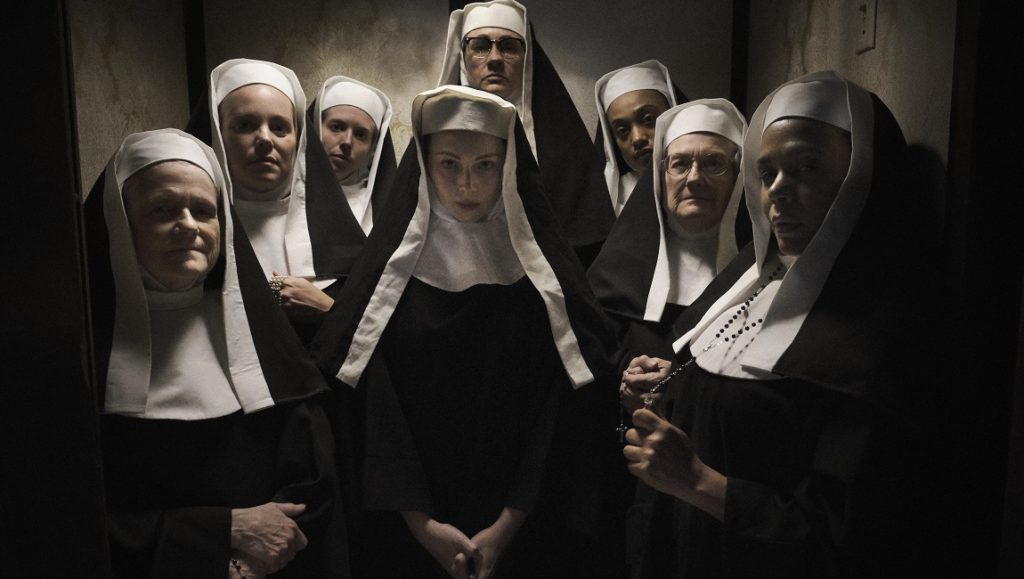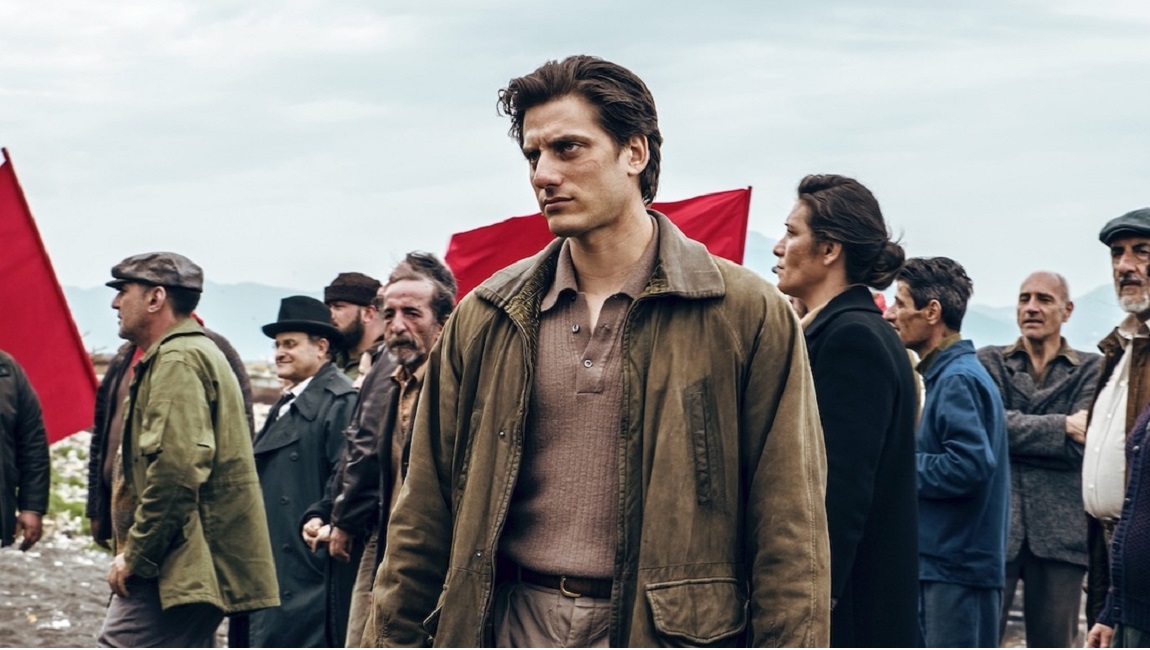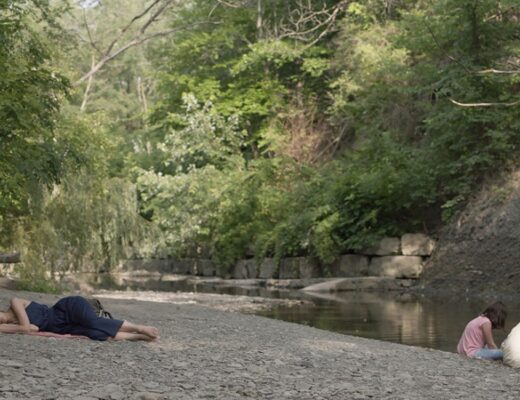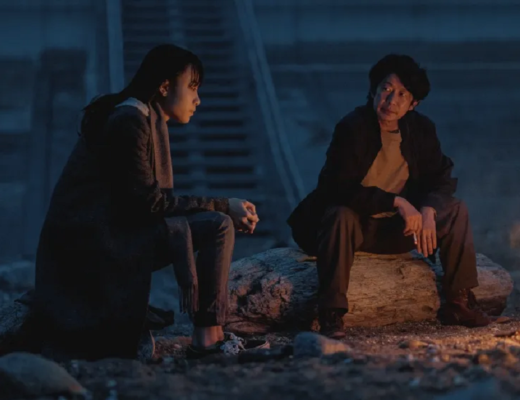All These Sons
Filmmaker Bing Liu became a notable name quite suddenly in 2018 when his feature debut Minding the Gap premiered at Sundance, going on to be a critical favorite that year, as well as one of the Oscar nominees for Best Documentary Feature. A seemingly homegrown endeavor ushered along by non-profit production company Kartemquin Films, Minding the Gap was an intimate, personal story concerning Liu and two of his childhood skater friends who, now adults, are all coming to terms with trauma related to abusive father figures in their youth. This documentary proved Liu an adept, sensitive interviewer, and a director with a keen sense of how to construct a nonfiction narrative, which has lead to his name being attached to an A24 adaptation of Ocean Vuong’s novel On Earth We’re Briefly Gorgeous (though as of this writing the project is no longer listed on IMDb).
Bigger projects lay ahead for Liu, but in the interim he has put together a new, rather slight, documentary entitled All These Sons, co-directed and shot with Joshua Altman (Gap’s editor). A lackluster and impersonal follow-up, the 88-minute All These Sons attempts to provide a chronicle of the work performed by two activists in Chicago’s South and West Side neighborhoods, predominantly black communities nationally infamous for tragically high murder rates tied to gun violence. It’s a subject that has been broadly discussed in various media for well over a decade now, brought to the cultural forefront when drill icon King L first dubbed his home city Chiraq as a nod to the persistent atmosphere of violence gripping the aforementioned neighborhoods. In this light, All These Sons almost immediately tracks as an act of hubris, confirmed as such over the course of the film’s fleet runtime with little room for benefit of the doubt.
All These Sons splits its time between two primary subjects, Billy Moore, a caseworker with IMAN (Inner-City Muslim Action Network), and Marshall Hatch Jr., who runs the MAAFA Redemption Project. Both organizations seek to eliminate gang activity in their respective communities, while also providing regular counseling, rehabilitation, job training, and residence for local (primarily young) Black men who have experienced or perpetrated gun violence. The work and dedication put in by these two men and the team of activists and volunteers surrounding them is remarkable and often inspiring, but All These Sons barely has time to fully assess either of their stories. The film has even less time with which to take in the full, systemic scope of its subject, never pulling back from on-the-ground struggle so as to interrogate the way in which American society has been purposefully constructed to favor whiteness and, by extension, maintain and perpetuate violence and dissonance within non-white communities (the closest the film gets to making this point is a scene set at a town hall meeting where Hatch lectures one of the men in his program on the need to participate in local politics; not very close at all).
All These Sons doesn’t even really have time to tell the story of the men who these programs service, opting to focus on one individual whose tumultuous journey is hastily edited, impatiently taking him from his lowest point to a moment of perseverance with no consideration to pace or audience investment. One can see why Liu assumed this could make for a strong follow up to Minding the Gap, another story of toxic masculinity and men helping other men sort through their trauma, but without personal investment Liu is unable to perceive a bigger sociological/political picture (it’s possible that this was a strategic choice to avoid friction with Hatch’s more conservative-leaning Christian org, but either way, not one that inspires confidence in the sensibilities behind this project). The end results are shallow and generic, signs that this production was undertaken not because the filmmakers felt like it was a story they needed to tell, but because it was available to them.
Writer: M.G. Mailloux

Credit: Agnes of God, LLC
Agnes
Prolific Oklahoma underground filmmaker Mickey Reece is out there blowing up everyone’s spot again with another affecting and deeply idiosyncratic work that — like previous films such as Climate of the Hunter or Alien — is as specific as it is almost uncategorizable. Agnes is part horror film and part camp comedy, a drama of isolation and melancholy, and an investigation of the ways in which faith both shields us from and disguises the harsher realities of a mundane world.
It begins with the title character, a nun who might be possessed by a demon. The church calls in somewhat disfavored priest Father Donaghue (regular Reece collaborator Ben Hall), partly because he’s one of the only trained exorcists, but mostly because they want him to fail so they can kick him loose. The old priest brings a young priest, of course, enthusiastic Ben (Jake Horowitz), full of youthful integrity and faith. That’s the general setup, and while the first half of Agnes takes place in the hermetic, often bizarrely humorous world of the convent, it’s the second half that gives the film its resonance. After the exorcism, Agnes’ friend Sister Mary (Molly Quinn), herself still reeling from the loss of a child and discombobulated by the events’ witnesses, leaves the church. Much as the sisters are isolated from the outside world within the convent walls, now Mary is merely differently isolated from that same world by her status as a former nun and by the pain she’s tried to escape. The meaning and solace she sought in faith has been erased.
Quinn’s performance is truly remarkable, unself-conscious but mannered and a little awkward, as Mary seems both worldly by fact of her past experiences but also completely unprepared for re-entry. In the first half of the film, Reece finds her in the background or off to the sides, but as Mary takes over the movie, she’s isolated in larger, more oppressive frames. As a director, Reece keeps building on his previous work. Agnes has elements of the regional horror chamber drama of Climate of the Hunter, but the sly humor and careful observation of unvarnished humanity has bled over into a more recognizable everyday world here. His movies, as they grow increasingly more ambitious, are nothing less than unique, revealing — and indicting — the miserable aesthetic homogeneity and almost total lack of imagination in modern indie genre filmmaking. He’s the real thing, and Agnes is his best work to date.
Writer: Matt Lynch
My Heart Can’t Beat Unless You Tell It To
There’s an aching sense of longing at the center of My Heart Can’t Beat Unless You Tell It To, the debut feature by Jonathan Cuartas. It’s a big open wound of a film, a gutting exploration of familial obligations and the all too familiar feeling of being held back and dragged down by those you love and, secretly, loathe. As the film begins, Dwight (Patrick Fugit) is picking up a homeless man with promises of a warm meal and a bed at a shelter. Instead, Dwight takes him to a secluded house and proceeds to knock him unconscious, drag his body inside, and with the help of Jessie (Ingrid Sophie Schram), opens up the man’s neck, emptying his blood into a bucket. Jessie prepares a bowl of the viscous red stuff and feeds it to bedridden Thomas (Owen Campbell), who, after drinking it down greedily, is suddenly reinvigorated. Thomas is a vampire, of course, and while the film never actually uses the term, it thankfully doesn’t play coy with it either. Dwight and Jessie and Thomas are siblings, and it’s clear that Dwight and Jessie have been feeding their younger brother this way for some time. They’ve got the post-meal routine down pat, a process involving burying the bodies, then washing and selling the victim’s clothes to a thrift shop for cash. But the seams are showing; Dwight has grown weary of killing, while Jessie has become callous to it, determined to do whatever it takes to keep Thomas alive. It’s an untenable situation.
Cuartas’ film takes its name from the lyrics of Helene Smith‘s song “I’m Controlled by Your Love,” which Jessie sings aloud on screen at one point. Another lyric goes “there are things I should do, but I know it’s just no use,” which might as well be Dwight’s motto. One of the things Cuartas does so well is map a typical sibling dynamic over the frame of the vampirism metaphor. Jessie is the oldest, in control and bossy. Thomas is the moody teenager, who chafes under the rules of the house (in this case, no going outside, ever, and always staying asleep during the daylight hours). Dwight is the middle child, the peacemaker who wants to smooth everything over. But Jessie secretly fumes when she discovers that Dwight is frequenting a local prostitute that she has earmarked for Thomas’ dinner, and Thomas is so desperate to make friends that he risks exposing his entire family by leaving notes outside for neighborhood kids to find. Tragedy ultimately strikes, and it’s genuinely heartbreaking to see these broken people’s lives crumble apart. The entire cast does great work, but Fugit in particular gives the film its delicate beating heart; here, he’s the soul, and his performance is all quiet despair and gut-wrenching melancholy. Cuartas smartly doesn’t force his metaphor; Thomas frequently resembles a drug addict, begging for a fix while his family deals with his peaks and valleys, but really his condition could stand in for any number of ailments. Dwight loves him and wants to care for him, but has forfeited his own life in the process.
Shooting in the squarish academy ratio, Cuartas and cinematographer Michael Cuartas (they’re brothers) create a series of cramped compositions that emphasize claustrophobic interiors and isolate the individual family members within the angular architecture of their old home. Indeed, time seems to stand still in this charnel house, with its bare walls, creaky furniture, and outdated television. There’s very little camera movement, and the gradual accumulation of locked-down master shots takes on an aura of portraiture, like flipping through a macabre family photo album. It’s an airless, oppressive film, as much a glacially-paced psychodrama as a horror film (although it has several horrific scenes; this is hardly a bloodless affair). Cuartas has assembled nothing less than a remarkable movie, the kind of horror film that leaves marks.
Writer: Daniel Gorman

Credit: Nick Shamblott
Shapeless
Ivy (co-screenwriter Kelly Murtagh), a New Orleans lounge singer wanting to break through to stardom, is also confronting an eating disorder that threatens to upend her dreams. She desperately tries to hide her secret, but eventually the seams of her life unravel around it. Pitching itself — to its detriment — as a horror film, Samantha Aldana’s Shapeless clearly has another project on its mind. Even while it occasionally provides a nifty bit of body horror imagery (a gruesome wound here, or a particularly effective vision of dozens of fingers protruding from Ivy’s skin), the focus is on simple drama. But since the writing is so pat, and the horror elements so infrequent, there’s just nothing here to elevate the material above generic indie noodling.
Murtagh is clearly doing her best, but her quiet performance is mostly undone by Aldana’s direction; while there are some arresting images — constant mirroring, or a recurring motif of faces and bodies under sheets or plastic — this is awash in ostentatiously off-kilter framing (the Mr. Robot syndrome) and filmed almost entirely in equally televisual soft focus. The generic score, so full of pizzicato or discordant strings, is likewise enervating, and feels like it could have been snagged from any other low-budget horror flicks. But the real problem is simply that — like so many similar characters in similar films like Swallow or even Midsommar — we never materially learn anything about Ivy beyond the fact of her condition/trauma. It’s the sole defining element of her personality, of Murtagh’s performance, and ultimately of Shapeless as a whole, which is nothing more than a big clunky metaphor for itself.
Writer: Matt Lynch
The Justice of Bunny King
Who exactly is Bunny King? Fighter and protector? Loving mother of two? Kind soul and hard worker? Or is she a bleak shadow of the current negligence found within New Zealand’s welfare & child services system? Throughout the duration of Gaysorn Thavat’s debut feature, The Justice of Bunny King, we follow the eponymous protagonist on a journey of resilience and camaraderie, and through the cycles of systematic malpractice. The film’s very title is an ironic sentiment, one that further magnifies King’s everyday tribulations. Homeless and working as a self-employed windshield cleaner on the hectic streets of her hometown, Thavat fixes viewers firmly in Bunny’s shoes, an effort to empathically communicate the film’s dense portrait of social desperation. Bunny King never resorts to needless cliches or any texture of exploitative poverty porn, its story instead following in the path of a commanding performance from Essie Davis. Where the film could have easily bordered on domestic melodrama during its lighter moments — ones filled with contrasting instances of kindness and prosperity — there’s a consistency and restraint to Davis’ portrayal of Bunny King and her family-focused aspirations.
The film’s narrative fodder addresses housing shortages, employment scarcity, domestic abuse, and other social hardships that continuously disrupt Bunny’s familial stability, but Thavat is careful to illuminate glimmers of hope amidst the series of dreary developments. But these moments of relief are also the primary root of the film’s considerable tonal whiplash. While such occasional buoyancy is essential to avoiding the exploitation and triteness that comes with the utilization of casual human suffering as an opportunity for entertainment, The Justice of Bunny King’s greatest flaw is in forgetting to leave discernible breathing room between its thematically and emotionally polar plot points. Clocking in at only 100 minutes, Thavat’s film — at least this vision of it — would have benefited from an elongation of plot, giving more space in order to emphasize the film’s narrative progression and sudden escalation of King’s frustration.
But even given the occasional tonal missteps, the film rallies for an enthralling and necessary third act. Boasting a one-location sequence of fiery turmoil, The Justice of Bunny King quickly transforms itself from steadfast realism to high-stakes suspense thriller, and more importantly, does so organically, its attempts to emphasize King’s internal and external dilemmas regarding a system that constantly belittles homespun hostility and other cases of domestic violence made manifest its visuals. It’s a sudden but necessary narrative gambit, one which powerfully punctuates Bunny King’s tragedy and unveils new layers of ambiguity, and culminates in a final minute of heart-rending drama.
Writer: David Cuevas

Credit: Tribeca Film Festival
The Kids
At the end of The Kids, Eddie Martin’s where-are-they-now documentary tracing the fortunes of the street kids featured in the hedonistic 1995 teen movie spectacle Kids, a closing title card tells us that director Larry Clark and screenwriter Harmony Korine declined to participate. This news will come as no surprise, given that The Kids basically accuses them both of exploiting the inexperienced non-professionals who acted in their film (and who were paid a pittance), then immediately abandoning them after the shoot, while parlaying the popularity and notoriety of Kids into lucrative careers lasting to this day.
The story of the documentary is largely told through the perspective of Hamilton Harris, one of Kids’ actors, who originated the project and is a producer and co-writer. Harris didn’t have a big role – he’s the guy who gives a tutorial on how to properly roll blunts – but he was a major participant in New York’s East Village-based skateboarding scene that inspired Kids and was a major source of the film’s casting. What’s made very clear in Harris’ narrative is that it’s the outsiders to this scene — most notably Clark and Korine — who profited the most from Kids, while those like himself, who represented the film’s ersatz “authenticity,” were largely left behind.
The tragic qualities of this story primarily derive from the fates of Harold Hunter and Justin Pierce, two of Kids’ most prominent performers. Hunter was especially magnetic, able to instantly befriend just about anyone, and who eagerly welcomed people into his social circle. He brought Midwestern transplant Harmony Korine into the skateboarding scene, and assured his initially skeptical friends that this weird old guy named Larry Clark who started hanging around, dressing like the kids to try to fit in, was actually alright. Pierce was also an instantly memorable character, a good-looking guy whose cheerful demeanor belied his hard life as a homeless street kid.
By all accounts, the Kids shooting atmosphere more resembled the site of a potential orgy than a professional film set, with alcohol, weed, and other drugs readily available. Nevertheless, a completed film somehow came together, and after making a big splash at the Cannes Film Festival – which the kids in Kids were not invited to – it did gangbusters box office business, grossing over 20 million worldwide on a 1.5 million budget. Long after the Kids shoot wrapped, but before the film was released, Clark invited the cast to a lavish shindig that included a screening and the handing out of $1000 bonuses, making the cast sign away rights to future profits. This, along with Clark and Korine’s subsequent ghosting, disillusioned most of the kids, but Hunter and Pierce still held out hope for future careers, both moving to Los Angeles to pursue acting. Pierce made some initial headway, while Hunter struggled to find work. They partied hard, sinking deeper into alcohol and drug addiction, and after the work and fame dried up, they both suffered early demises: Pierce in 2000 by suicide at 25, Hunter in 2006 by a drug-induced heart attack at 31.
The Kids, however, isn’t all tragedy; some made it out intact, notably Harris, who eventually was able to come to terms with his experiences and do some self-healing, and thus live to tell the tale he relates so compellingly here. In its own way, The Kids is just as cautionary as the original film that inspired it.
Writer: Christopher Bourne







